Python源码阅读-内存管理机制(一)
==========================
基本阅读完了, 只是没时间梳理, 趁着这今天时间比较空
逐步梳理, 发上来……也算是小结下, 要开始准备简历找工作了>_<#
这篇略长, 带很多图, 所以一分为二
Python的内存管理架构
基本分层
在Objects/obmalloc.c源码中, 给了一个分层划分
_____ ______ ______ ________
[ int ] [ dict ] [ list ] ... [ string ] Python core |
+3 | <----- Object-specific memory -----> | <-- Non-object memory --> |
_______________________________ | |
[ Python's object allocator ] | |
+2 | ####### Object memory ####### | <------ Internal buffers ------> |
______________________________________________________________ |
[ Python's raw memory allocator (PyMem_ API) ] |
+1 | <----- Python memory (under PyMem manager's control) ------> | |
__________________________________________________________________
[ Underlying general-purpose allocator (ex: C library malloc) ]
0 | <------ Virtual memory allocated for the python process -------> |
=========================================================================
_______________________________________________________________________
[ OS-specific Virtual Memory Manager (VMM) ]
-1 | <--- Kernel dynamic storage allocation & management (page-based) ---> |
__________________________________ __________________________________
[ ] [ ]
-2 | <-- Physical memory: ROM/RAM --> | | <-- Secondary storage (swap) --> |
可以看到
layer 3: Object-specific memory(int/dict/list/string....)
Python 实现并维护
更高抽象层次的内存管理策略, 主要是各类特定对象的缓冲池机制. 具体见前面几篇涉及的内存分配机制
layer 2: Python's object allocator
Python 实现并维护
实现了创建/销毁Python对象的接口(PyObject_New/Del), 涉及对象参数/引用计数等
layer 1: Python's raw memory allocator (PyMem_ API)
Python 实现并维护, 包装了第0层的内存管理接口, 提供统一的raw memory管理接口
封装的原因: 不同操作系统 C 行为不一定一致, 保证可移植性, 相同语义相同行为
layer 0: Underlying general-purpose allocator (ex: C library malloc)
操作系统提供的内存管理接口, 由操作系统实现并管理, Python不能干涉这一层的行为
第三层layer 3前面已经介绍过了, 几乎每种常用的数据类型都伴有一套缓冲池机制.
在这里, 我们关注的是layer 2/1
简要介绍下layer 1, 然后重点关注layer 2, 这才是重点
layer 1: PyMem_ API
PyMem_ API是对操作系统内存管理接口进行的封装
查看pymem.h可以看到
// Raw memory interface
// 这里存在三个宏定义, 宏可以避免一次函数调用的开销, 提高运行效率
// 不允许非配空间大小为0的内存空间
#define PyMem_MALLOC(n) ((size_t)(n) > (size_t)PY_SSIZE_T_MAX ? NULL \
: malloc((n) ? (n) : 1))
#define PyMem_REALLOC(p, n) ((size_t)(n) > (size_t)PY_SSIZE_T_MAX ? NULL \
: realloc((p), (n) ? (n) : 1))
#define PyMem_FREE free
// 这里做了三个函数的声明, 平台独立的 malloc/realloc/free
PyAPI_FUNC(void *) PyMem_Malloc(size_t);
PyAPI_FUNC(void *) PyMem_Realloc(void *, size_t);
PyAPI_FUNC(void) PyMem_Free(void *);
// ============================================================
// Type-oriented memory interface
// 这里还有三个类型相关的内存接口, 批量分配/重分配 n 个 类型为 type内存
#define PyMem_New(type, n) \
( ((size_t)(n) > PY_SSIZE_T_MAX / sizeof(type)) ? NULL : \
( (type *) PyMem_Malloc((n) * sizeof(type)) ) )
#define PyMem_NEW(type, n) \
( ((size_t)(n) > PY_SSIZE_T_MAX / sizeof(type)) ? NULL : \
( (type *) PyMem_MALLOC((n) * sizeof(type)) ) )
#define PyMem_Resize(p, type, n) \
( (p) = ((size_t)(n) > PY_SSIZE_T_MAX / sizeof(type)) ? NULL : \
(type *) PyMem_Realloc((p), (n) * sizeof(type)) )
#define PyMem_RESIZE(p, type, n) \
( (p) = ((size_t)(n) > PY_SSIZE_T_MAX / sizeof(type)) ? NULL : \
(type *) PyMem_REALLOC((p), (n) * sizeof(type)) )
然后object.c中, 我们关注实现, 三个实现的函数调用了对应的宏
// 使用 C 写Python扩展模块时使用函数而不是对应的宏
void *
PyMem_Malloc(size_t nbytes)
{
return PyMem_MALLOC(nbytes);
}
void *
PyMem_Realloc(void *p, size_t nbytes)
{
return PyMem_REALLOC(p, nbytes);
}
void
PyMem_Free(void *p)
{
PyMem_FREE(p);
}
这些接口都相对简单
好了, 结束, 开始关注layer 2: Python's object allocator
Python 的内存分配策略
先来看Objects/obmalloc.c中的一段注释
/*
* "Memory management is where the rubber meets the road -- if we do the wrong
* thing at any level, the results will not be good. And if we don't make the
* levels work well together, we are in serious trouble." (1)
*
* (1) Paul R. Wilson, Mark S. Johnstone, Michael Neely, and David Boles,
* "Dynamic Storage Allocation: A Survey and Critical Review",
* in Proc. 1995 Int'l. Workshop on Memory Management, September 1995.
*/
Python引入了内存池机制, 用于管理对小块内存的申请和释放
逻辑
1. 如果要分配的内存空间大于 SMALL_REQUEST_THRESHOLD bytes(512 bytes), 将直接使用layer 1的内存分配接口进行分配
2. 否则, 使用不同的block来满足分配需求
整个小块内存池可以视为一个层次结构
1. 内存池(概念上的, 标识Python对于整个小块内存分配和释放的内存管理机制)
2. arena
3. pool
4. block
block
Python内存的最小单位, 所有block长度都是8字节对齐的
注意这里block只是一个概念, 在源代码中并没有实体存在.
不同类型block, 对应不同内存大小, 这个内存大小的值被称为size class.
不同长度的block
* Request in bytes Size of allocated block Size class idx
* ----------------------------------------------------------------
* 1-8 8 0
* 9-16 16 1
* 17-24 24 2
* 25-32 32 3
* 33-40 40 4
* 41-48 48 5
* 49-56 56 6
* 57-64 64 7
* 65-72 72 8
* ... ... ...
* 497-504 504 62
* 505-512 512 63
*
* 0, SMALL_REQUEST_THRESHOLD + 1 and up: routed to the underlying
* allocator.
*/
例如
申请一块大小28字节的内存, 实际从内存中划到32字节的一个block (从size class index为3的pool里面划出)
图示:
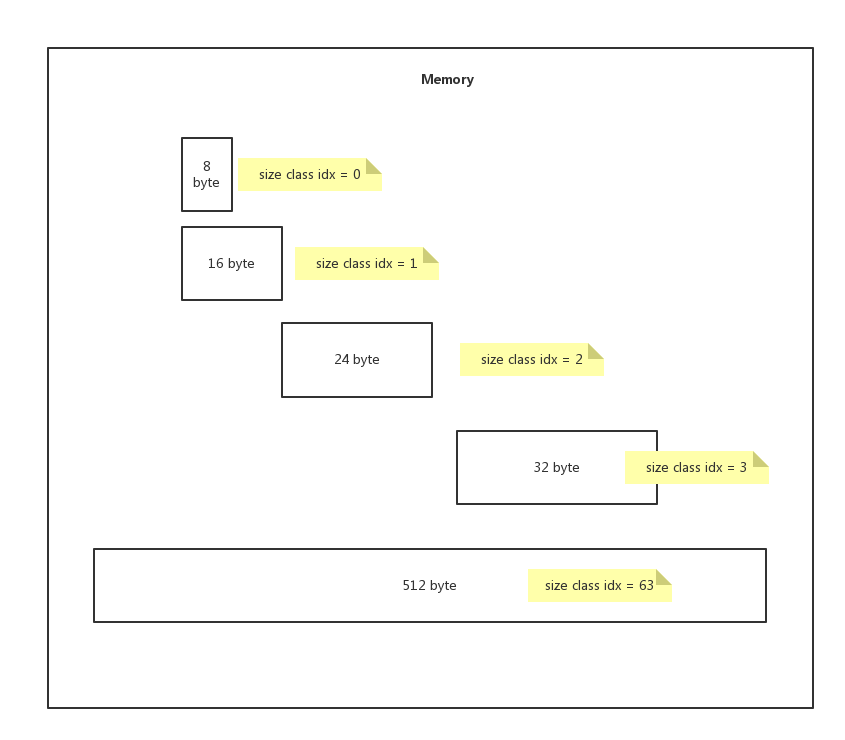
注意: 这里有个Size class idx, 这个主要为了后面pool中用到
size class和size class index之间的转换
#define ALIGNMENT 8 /* must be 2^N */
#define ALIGNMENT_SHIFT 3
#define ALIGNMENT_MASK (ALIGNMENT - 1)
// size class index => size class
#define INDEX2SIZE(I) (((uint)(I) + 1) << ALIGNMENT_SHIFT)
/* 即
(0+1) * 8 = 8
(1+1) * 8 = 16
*/
// size class => size class index
size = (uint)(nbytes - 1) >> ALIGNMENT_SHIFT;
/* 即
(8 - 1) / 8 = 0
(16 - 8) / 8 = 1
*/
pool
pool管理block, 一个pool管理着一堆有固定大小的内存块
本质: pool管理着一大块内存, 它有一定的策略, 将这块大的内存划分为多个大小一致的小块内存.
pool size
在Python中, 一个pool的大小通常为一个系统内存页. 4kB
obmalloc.c
#define SYSTEM_PAGE_SIZE (4 * 1024)
#define SYSTEM_PAGE_SIZE_MASK (SYSTEM_PAGE_SIZE - 1)
#define POOL_SIZE SYSTEM_PAGE_SIZE /* must be 2^N */
#define POOL_SIZE_MASK SYSTEM_PAGE_SIZE_MASK
pool组成
pool的4kB内存 = pool_header + block集合(N多大小一样的block)
pool_header
/* Pool for small blocks. */
struct pool_header {
union { block *_padding;
uint count; } ref; /* number of allocated blocks */
block *freeblock; /* pool's free list head */
struct pool_header *nextpool; /* next pool of this size class */
struct pool_header *prevpool; /* previous pool "" */
uint arenaindex; /* index into arenas of base adr */
uint szidx; /* block size class index */ - size class index
uint nextoffset; /* bytes to virgin block */
uint maxnextoffset; /* largest valid nextoffset */
};
pool_header的作用
1. 与其他pool链接, 组成双向链表
2. 维护pool中可用的block, 单链表
3. 保存 szidx , 这个和该pool中block的大小有关系, (block size=8, szidx=0), (block size=16, szidx=1)...用于内存分配时匹配到拥有对应大小block的pool
4. arenaindex, 后面说
结构图:
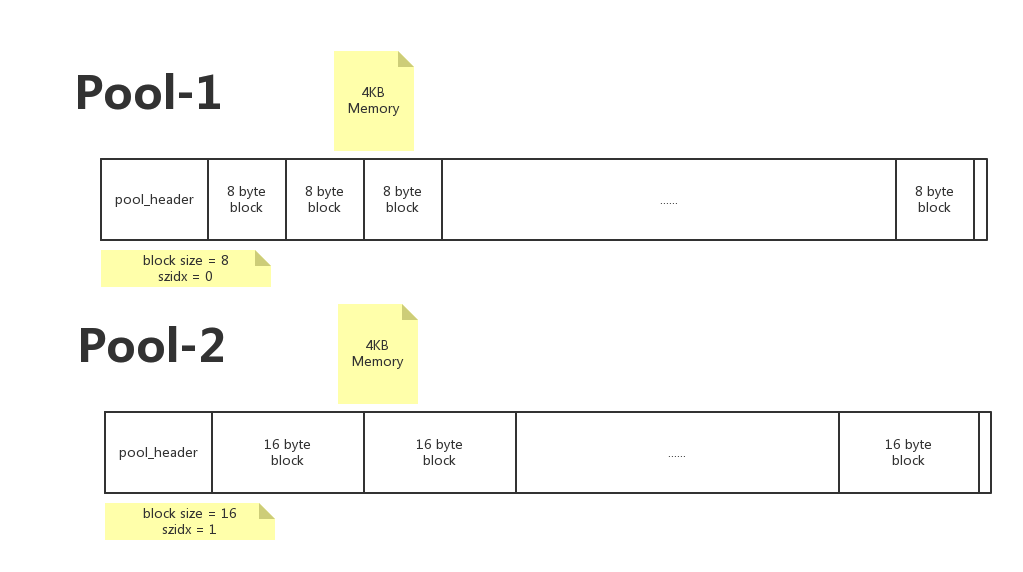
pool初始化
从内存中初始化一个全新的空的pool
Objects/obmalloc.c的
void *
PyObject_Malloc(size_t nbytes)
{
...
init_pool:
// 1. 连接到 used_pools 双向链表, 作为表头
// 注意, 这里 usedpools[0] 保存着 block size = 8 的所有used_pools的表头
/* Frontlink to used pools. */
next = usedpools[size + size]; /* == prev */
pool->nextpool = next;
pool->prevpool = next;
next->nextpool = pool;
next->prevpool = pool;
pool->ref.count = 1;
// 如果已经初始化过了...这里看初始化, 跳过
if (pool->szidx == size) {
/* Luckily, this pool last contained blocks
* of the same size class, so its header
* and free list are already initialized.
*/
bp = pool->freeblock;
pool->freeblock = *(block **)bp;
UNLOCK();
return (void *)bp;
}
/*
* Initialize the pool header, set up the free list to
* contain just the second block, and return the first
* block.
*/
// 开始初始化pool_header
// 这里 size = (uint)(nbytes - 1) >> ALIGNMENT_SHIFT; 其实是Size class idx, 即szidx
pool->szidx = size;
// 计算获得每个block的size
size = INDEX2SIZE(size);
// 注意 #define POOL_OVERHEAD ROUNDUP(sizeof(struct pool_header))
// bp => 初始化为pool + pool_header size, 跳过pool_header的内存
bp = (block *)pool + POOL_OVERHEAD;
// 计算偏移量, 这里的偏移量是绝对值
// #define POOL_SIZE SYSTEM_PAGE_SIZE /* must be 2^N */
// POOL_SIZE = 4kb, POOL_OVERHEAD = pool_header size
// 下一个偏移位置: pool_header size + 2 * size
pool->nextoffset = POOL_OVERHEAD + (size << 1);
// 4kb - size
pool->maxnextoffset = POOL_SIZE - size;
// freeblock指向 bp + size = pool_header size + size
pool->freeblock = bp + size;
// 赋值NULL
*(block **)(pool->freeblock) = NULL;
UNLOCK();
return (void *)bp;
}
初始化后的图
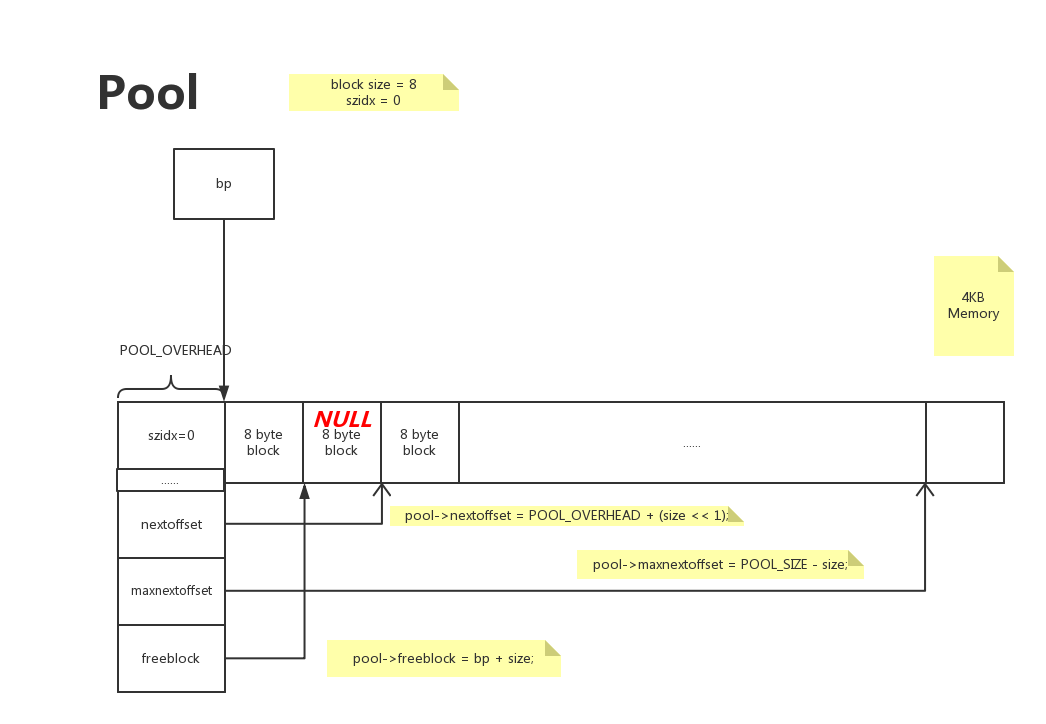
pool进行block分配 - 0 总体代码
总体分配的代码如下
if (pool != pool->nextpool) { //
/*
* There is a used pool for this size class.
* Pick up the head block of its free list.
*/
++pool->ref.count;
bp = pool->freeblock; // 指针指向空闲block起始位置
assert(bp != NULL);
// 代码-1
// 调整 pool->freeblock (假设A节点)指向链表下一个, 即bp首字节指向的下一个节点(假设B节点) , 如果此时!= NULL
// 表示 A节点可用, 直接返回
if ((pool->freeblock = *(block **)bp) != NULL) {
UNLOCK();
return (void *)bp;
}
// 代码-2
/*
* Reached the end of the free list, try to extend it.
*/
// 有足够的空间, 分配一个, pool->freeblock 指向后移
if (pool->nextoffset <= pool->maxnextoffset) {
/* There is room for another block. */
// 变更位置信息
pool->freeblock = (block*)pool +
pool->nextoffset;
pool->nextoffset += INDEX2SIZE(size);
*(block **)(pool->freeblock) = NULL; // 注意, 指向NULL
UNLOCK();
// 返回bp
return (void *)bp;
}
// 代码-3
/* Pool is full, unlink from used pools. */ // 满了, 需要从下一个pool获取
next = pool->nextpool;
pool = pool->prevpool;
next->prevpool = pool;
pool->nextpool = next;
UNLOCK();
return (void *)bp;
}
pool进行block分配 - 1 刚开始
内存块尚未分配完, 且此时不存在回收的block, 全新进来的时候, 分配第一块block
(pool->freeblock = *(block **)bp) == NULL
所以进入的逻辑是代码-2
bp = pool->freeblock; // 指针指向空闲block起始位置
.....
// 代码-2
/*
* Reached the end of the free list, try to extend it.
*/
// 有足够的空间, 分配一个, pool->freeblock 指向后移
if (pool->nextoffset <= pool->maxnextoffset) {
/* There is room for another block. */
// 变更位置信息
pool->freeblock = (block*)pool +
pool->nextoffset;
pool->nextoffset += INDEX2SIZE(size);
*(block **)(pool->freeblock) = NULL; // 注意, 指向NULL
UNLOCK();
// 返回bp
return (void *)bp;
}
结果图示
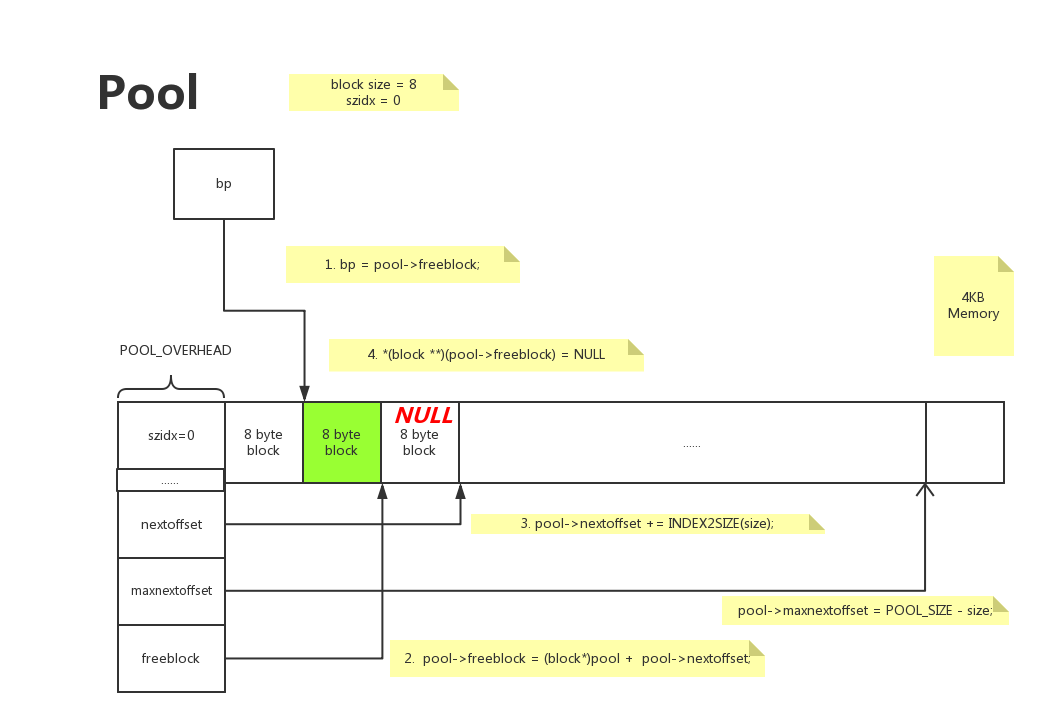
pool进行block分配 - 2 回收了某几个block
回收涉及的代码
void
PyObject_Free(void *p)
{
poolp pool;
block *lastfree;
poolp next, prev;
uint size;
pool = POOL_ADDR(p);
if (Py_ADDRESS_IN_RANGE(p, pool)) {
/* We allocated this address. */
LOCK();
/* Link p to the start of the pool's freeblock list. Since
* the pool had at least the p block outstanding, the pool
* wasn't empty (so it's already in a usedpools[] list, or
* was full and is in no list -- it's not in the freeblocks
* list in any case).
*/
assert(pool->ref.count > 0); /* else it was empty */
// p被释放, p的第一个字节值被设置为当前freeblock的值
*(block **)p = lastfree = pool->freeblock;
// freeblock被更新为指向p的首地址
pool->freeblock = (block *)p;
// 相当于往list中头插入了一个节点
...
}
}
没释放一个block, 该block就会变成 pool->freeblock 的头节点, 而单链表一个节点如何指向下一个节点呢? 通过赋值, 节点内存空间保存着下个节点的地址, 最后一个节点指向NULL(知道上面代码-1的判断条件了吧>_<#)
假设已经连续分配了5块, 第1块和第4块被释放
此时内存图示
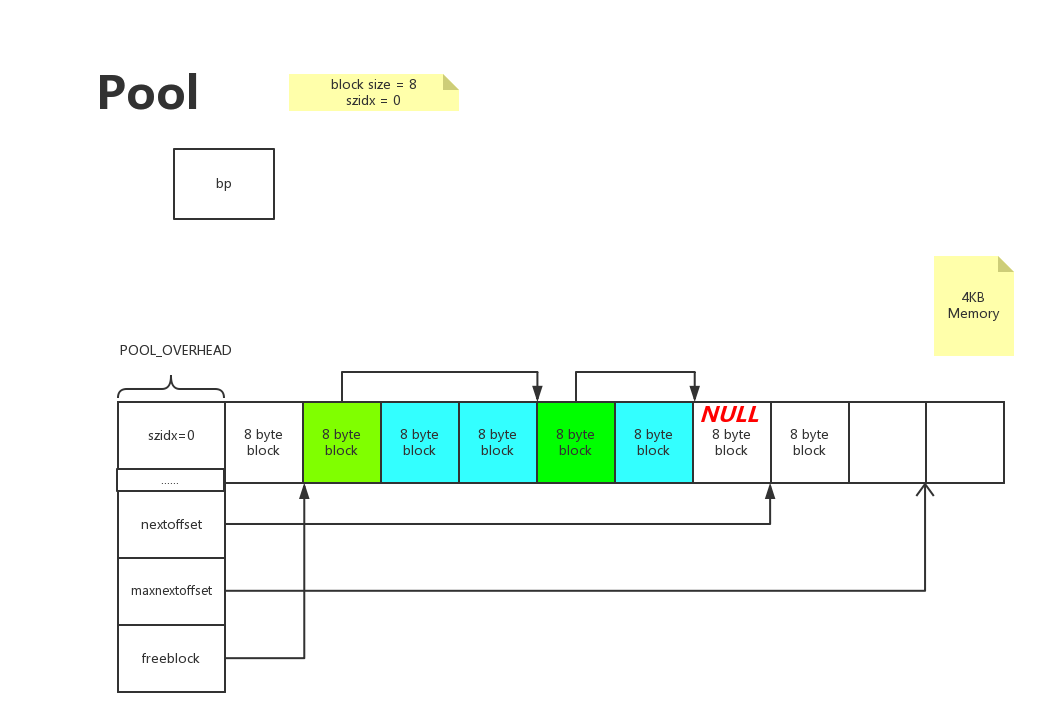
此时再一个block分配调用进来, 执行分配, 进入的逻辑是代码-1
bp = pool->freeblock; // 指针指向空闲block起始位置
// 代码-1
// 调整 pool->freeblock (假设A节点)指向链表下一个, 即bp首字节指向的下一个节点(假设B节点) , 如果此时!= NULL
// 表示 A节点可用, 直接返回
if ((pool->freeblock = *(block **)bp) != NULL) {
UNLOCK();
return (void *)bp;
}
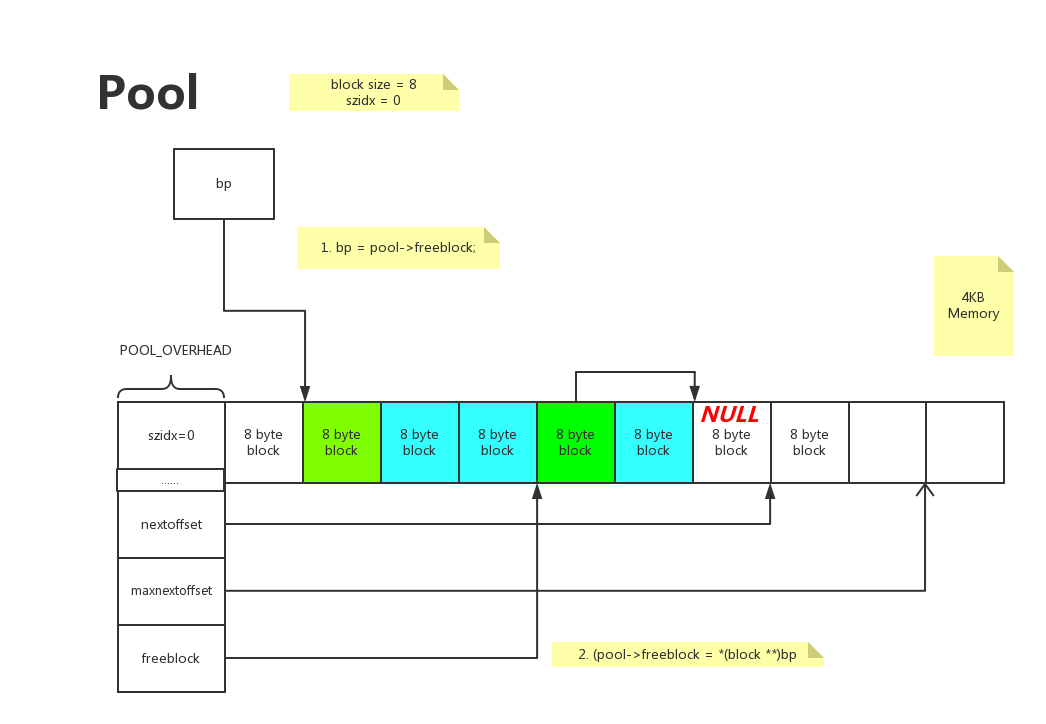
pool进行block分配 - 3 pool用完了
pool中内存空间都用完了, 进入代码-3
bp = pool->freeblock; // 指针指向空闲block起始位置
// 代码-3
/* Pool is full, unlink from used pools. */ // 满了, 需要从下一个pool获取
next = pool->nextpool;
pool = pool->prevpool;
next->prevpool = pool;
pool->nextpool = next;
UNLOCK();
return (void *)bp;
获取下一个pool(链表上每个pool的block size都是一致的)
好了, pool到此位置, 下篇进入arena